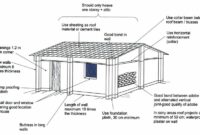Hurricane Resistant Home – As hurricanes become more frequent and intense due to climate change, building a hurricane-resistant home has never been more essential.
A hurricane-resistant home is designed and constructed to withstand extreme winds, heavy rain, and flying debris, which can significantly reduce damage and ensure the safety of its occupants.
Here, we’ll explore the key features, materials, and designs that go into making a home resilient against hurricane-force winds.
The American Society of Civil Engineers (ASCE) 7 standard, specifically ASCE 7-22, is a crucial part of U.S. building codes for hurricane-resistant homes. It provides detailed guidelines on minimum design loads for structures, including wind, seismic, and flood loads.
Key Aspects of ASCE 7 for Hurricane Resistance
- Wind Load Requirements – ASCE 7 defines wind speed maps for different regions, ensuring homes can withstand hurricane-force winds based on their location.
- Pressure Coefficients – It calculates the pressure acting on various building components (roofs, walls, windows).
- Structural Design Criteria – It establishes load combinations to ensure that buildings remain stable under extreme wind forces.
- Roof and Wall Systems – The standard specifies reinforcement methods to prevent structural failures due to wind uplift and pressure.
Integration with the International Building Code (IBC)
- The IBC adopts ASCE 7 as the primary reference for structural design against environmental loads.
- Many state and local governments in hurricane-prone areas (e.g., Florida, Texas, Louisiana) enforce even stricter regulations based on ASCE 7.
1. Location and Foundation
Before building a hurricane-resistant home, the choice of location is critical. Homes in hurricane-prone regions, such as coastal areas or low-lying places, need special consideration. Elevating the home on stilts or pilings can help protect it from storm surges, which are one of the most dangerous aspects of hurricanes.
The foundation must be anchored securely to resist uplift forces caused by high winds. Concrete slab foundations with deep footings or reinforced steel pilings are commonly used in hurricane-prone areas. This minimizes the risk of the home being lifted from its foundation – Hurricane Resistant Home.
2. Wind-Resistant Roof Design
Roof damage is one of the most common issues during hurricanes. To ensure a home is hurricane-resistant, special attention must be given to roof design and materials.
- Shape and Slope: A hip roof, which slopes on all sides, is more aerodynamic and better suited to resist high winds compared to gable roofs. The slope of the roof also helps to deflect wind pressure.
- Roofing Materials: High-quality materials like metal or impact-resistant shingles should be used to protect the roof from debris. Additionally, all roof edges and shingles should be securely fastened with hurricane clips or straps to the walls and trusses to ensure they stay in place during strong winds.
- Secondary Water Barriers: Adding a secondary water barrier under the roofing material is crucial to prevent water from penetrating the home if the roof is damaged.
Read also:
1. 101 Creative and Stunning Front Yard Corner Lot Landscaping Ideas
2. 69 No grass front yard ideas with Low Maintenance Design
3. Reinforced Walls and Windows
Walls and windows are the home’s primary line of defense against hurricane-force winds and flying debris.
- Concrete or Reinforced Block Walls: Homes built with materials such as reinforced concrete, insulated concrete forms (ICFs), or concrete blocks are much more resistant to wind pressure and debris impact than traditional wood-frame homes.
- Impact-Resistant Windows and Doors: Ordinary glass windows can easily shatter, leaving the interior vulnerable to the elements. Impact-resistant windows and doors are designed with laminated glass that can withstand debris and prevent breakage. Additionally, installing storm shutters can provide an extra layer of protection, especially for larger windows and glass doors.
4. Secure Openings
Openings such as doors and windows are particularly vulnerable during hurricanes. Ensuring these are adequately reinforced can prevent structural damage and reduce pressure differences inside the home.
- Garage Doors: Garage doors are especially vulnerable to wind damage. A hurricane-resistant garage door should be made from reinforced materials with strong bracing to prevent wind from entering and lifting the roof.
- Sealed Entry Points: All entry points, such as windows, doors, and vents, should be properly sealed with caulk or weatherstripping to prevent water intrusion during heavy rainfall.
5. Hurricane Straps and Clips
One of the most critical aspects of a hurricane-resistant home is the use of hurricane straps or clips.
These metal connectors securely tie the roof to the walls and the walls to the foundation, creating a continuous load path that transfers the wind’s force away from the home’s structure.
Without these reinforcements, high winds can easily tear the roof off or cause the walls to collapse.
6. Storm-Resistant Materials
Choosing durable, storm-resistant materials is essential for a hurricane-proof home. Materials like concrete, steel, and fiber cement are popular choices because of their strength and resilience.
- Concrete: As mentioned earlier, concrete walls are far more resistant to high winds and debris impact than wood-frame construction.
- Fiber Cement Siding: Fiber cement is both fire-resistant and able to withstand severe weather, making it a great option for siding.
- Metal Roofing: Metal roofing is highly resistant to high winds, flying debris, and even fire. It also lasts much longer than traditional asphalt shingles.
7. Energy Efficiency and Sustainability
A hurricane-resistant home doesn’t just need to be safe—it can also be energy-efficient and sustainable.
Choosing materials that are environmentally friendly and adding features like solar panels, energy-efficient windows, and insulation can help reduce energy costs while keeping the home more comfortable.
Building with Insulated Concrete Forms (ICF) can improve both energy efficiency and storm resistance. ICF walls provide excellent insulation, which helps regulate indoor temperatures while being incredibly strong.
8. Backup Power Solutions
During hurricanes, power outages can last for days or even weeks. A hurricane-resistant home should be equipped with a backup power system to ensure essential functions, such as refrigeration, lighting, and communications, can continue operating.
- Generators: Standby generators that automatically kick in during power outages are a popular solution for hurricane-prone homes.
- Solar Power: Homes with solar panels, especially those equipped with battery storage systems, can maintain power even when the grid goes down.
9. Elevating Critical Systems
To protect essential systems like HVAC units, water heaters, and electrical panels from flooding, these should be elevated above the expected flood level.
Installing them in an attic or on elevated platforms can help prevent costly damage during a hurricane.
10. Community and Zoning Regulations
Before building a hurricane-resistant home, it’s important to consult local building codes and zoning regulations.
Many coastal areas have strict requirements to ensure homes can withstand extreme weather events.
Adhering to these codes not only improves the resilience of your home but also ensures you meet insurance and legal requirements.
Conclusion
Building a hurricane-resistant home involves more than just selecting the right materials—it’s about creating a system of defenses against the destructive forces of nature.
From reinforced foundations and roofs to impact-resistant windows and hurricane straps, every aspect of the home’s design contributes to its ability to weather the storm.
With the proper planning and construction techniques, homeowners can ensure their homes remain safe and secure even in the face of increasingly severe hurricane seasons.
Hurricane Resistant Home: Alabama, Alaska, Arizona, Arkansas, California, Colorado, Connecticut, Delaware, Florida, Georgia, Hawaii, Idaho, Illinois, Indiana, Iowa, Kansas, Kentucky, Louisiana, Maine, Maryland, Massachusetts, Michigan, Minnesota, Mississippi, Missouri, Montana, Nebraska, Nevada, New Hampshire, New Jersey, New Mexico, New York, North Carolina, North Dakota, Ohio, Oklahoma, Oregon, Pennsylvania, Rhode Island, South Carolina, South Dakota, Tennessee, Texas, Utah, Vermont, Virginia, Washington, West Virginia, Wisconsin, Wyoming.
Buenos Aires, Argentina; São Paulo, Brazil; Rio de Janeiro, Brazil; Bogotá, Colombia; Lima, Peru; Santiago, Chile; Caracas, Venezuela; Montevideo, Uruguay; Quito, Ecuador; Asunción, Paraguay; La Paz, Bolivia; Sucre, Bolivia; Medellín, Colombia; Cali, Colombia; Guayaquil, Ecuador; Valparaíso, Chile; Rosario, Argentina; Córdoba, Argentina; Maracaibo, Venezuela; Barranquilla, Colombia; Manaus, Brazil.
Africa:
Cairo, Lagos, Nairobi, Dakar, Johannesburg, Casablanca, Addis Ababa, Accra, Tunis, Lusaka, Harare, Kampala, Algiers, Khartoum, Mogadishu, Freetown, Windhoek, Kigali, Bamako, Dar es Salaam.
Australia:
Sydney, Melbourne, Brisbane, Perth, Adelaide, Hobart, Darwin, Canberra, Gold Coast, Cairns, Newcastle, Wollongong, Geelong, Townsville, Launceston, Toowoomba, Ballarat, Bendigo, Albury, Rockhampton.
Europe:
London, Paris, Rome, Berlin, Madrid, Vienna, Amsterdam, Lisbon, Prague, Athens, Brussels, Copenhagen, Oslo, Dublin, Warsaw, Helsinki, Stockholm, Budapest, Edinburgh, Zurich, Munich.






